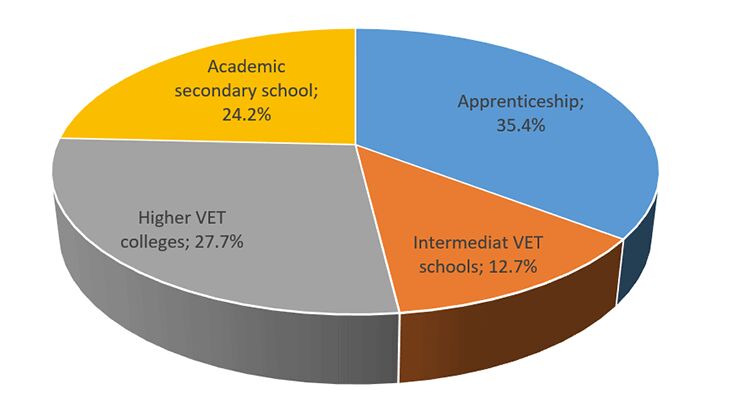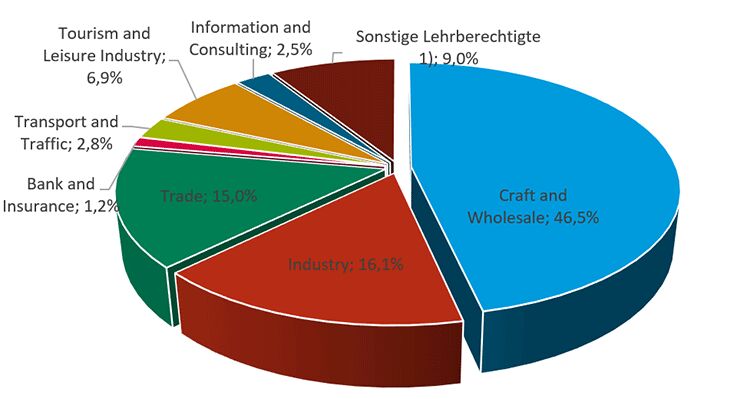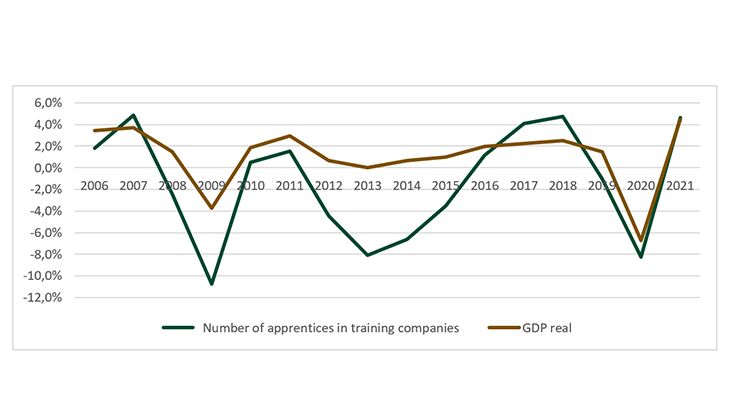Apprenticeship System
The apprenticeship system in Austria has a long history and is broadly accepted. The image of VET and the dual system is quite good: A total of three quarters of Austrian students are either in a school-based VET programme or in a dual track programme. Nevertheless, the competitive situation with school-based VET options, the demographic development showing a decrease in young people and a shortage of skilled labour are necessitating policy measures to enhance the attractiveness, image and quality of dual VET.
Competences (federal, regional)
The governance structure of the apprenticeship system involves a large number of actors. The tasks and competences in both the company-based part as well as the school-based part are divided among several bodies at federal, regional and local levels. The leading ministry for the company-based part is the Ministry for Labour and Economy; for the school-based part it is the Ministry of Education, Science and Research. The social partners that fulfil key tasks both regarding contents and administration of apprenticeship training play a particularly important role.
History of the apprenticeship system
The beginnings of company-based VET date back to the Middle Ages. During that period, trade associations carried out so-called master craftsperson apprenticeships. Towards the end of the 19th century, the public sector became involved in VET. The traditional craftsperson apprenticeship was complemented by school-based programmes.
In the period following World War I, major framework conditions were created for apprenticeship training which improved the protection of apprentices.
After World War II, the range of provisions of the Trade, Commerce and Industry Regulation Act (Gewerbeordnung, GewO) was bundled in the first draft of the Vocational Training Act (Berufsausbildungsgesetz, BAG), which entered into force in 1969. The 1978 amendment of this Act is basically still valid today. Apprenticeship Offices were set up in each province. The IVET trainer exam was introduced, which constitutes a prerequisite for becoming an IVET trainer. And the first steps were taken to list the job profiles, i.e. the in-company training curricula.
The image of VET and apprenticeship in society
At the upper secondary level, the Austrian education system is characterised by a well-developed and differentiated VET system. It consists of full-time VET schools (schools for intermediate vocational education [BMS] and colleges for higher vocational education [BHS]) and dual training [apprenticeships]). More than 75% of an age cohort in the tenth school year opt for a VET programme, with about half attending a school and half an apprenticeship.



VET is attractive and has a good image in Austria. But there is competition between the different educational tracks in general and between the dual system and full-time VET schools specifically. Demography showing a decrease in young people has even increased this competition in the last few years. Besides this, initial VET is facing new challenges. The young people who take up an apprenticeship have diverse requirements. This has resulted in a differentiation of apprenticeship programmes. Since 2003, young people with learning difficulties have had the possibility to prolong their apprenticeship period or to acquire partial qualifications. To raise attractiveness and to increase permeability, the Berufsmatura was introduced in 2008. It offers the possibility to obtain both a VET qualification and the higher education entrance qualification in one combined scheme.
Purpose
For the Austrian economy, the apprenticeship system with its long tradition and good image has always been the “usual way” to safeguard the supply of skilled labour. The involvement of the social partners in the governance structure of apprenticeship training secures its sustainability and further development.
Demographic development, the shortage of skilled workers and increasing (youth) unemployment rates have moved VET and the apprenticeship system up the political agenda. In 2013, the government decided on an “Education and training guarantee” till the age of 18. In 2018, an education and training obligation for all young persons under 18 was introduced (Ausbildungspflicht). The VET system with its variety of offers has been identified as a realistic answer to many (new) challenges. Public money is therefore being used for additional supra-company training places and other active labour market policy measures.
Apprentices, companies and VET schools involved in apprenticeship training
The Apprenticeship Statistics, which includes key statistical data, are published every year by the Austrian Federal Economic Chamber. For 2021, the following key data can be given.
- At the end of 2021, there were 107,593 apprentices (minus 0.8% as compared to 2020) in 28,461 Austrian companies (minus 0.9% as compared to 2020).
- About two thirds of all apprentices in 2021 were male (72,873), one third female (34,720).
- Distribution by economic sectors: Most apprentices are trained in the crafts and wholesales sector (46.5%), followed by the industry (16.1%) and trade sector (15.0%).
- Clear gender-specific trends are seen in the choice of apprenticeship occupations. More than 38.2% of all female apprentices are trained as shop assistants, office assistants and hairdressers. This quota has steadily decreased in recent years, which indicates that the choice of apprenticeship among women is becoming more and more diverse. The three most popular apprenticeship trades among young men are metal technology, followed by electrical engineering and motor vehicle engineering.
- Although there are 227 apprenticeship trades (cf. the List of Apprenticeships), young people show a clear preference towards certain trades. Almost two thirds of all female or male apprentices respectively are trained in the ten most popular apprenticeship trades. (https://www.wko.at/service/zahlen-daten-fakten/daten-lehrlingsstatistik.html).
- Cedefop (2020): Skills forecast
- Cedefop (2020): Vocational education and training for the future of work
- Economic Chambers (WKO) – on apprenticeship statistics
- ibw (2022): Survey of Apprenticeship training
- ibw and öibf (2022): Report on the Situation of Youth Employment and Apprenticeship Training in Austria 2020–2021